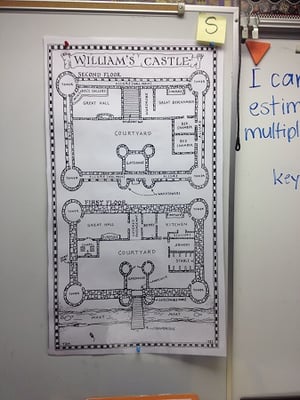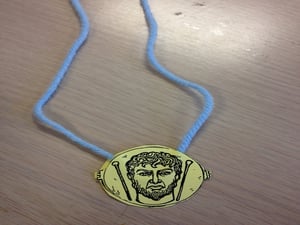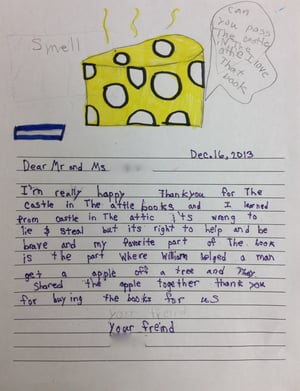My students are really into Castle in the Attic! We have almost reached the end of the second quadrant, so they have a good understanding of the characters and the problem that is developing. Imagine a giant GASP! when I read:
He could make her small and keep her. Of course, he could. With the token.
Once again we are using a chart, as well as the reader’s notebook, to keep track of the important events in the story.
 One thing the kids really loved is the diagram of the castle. They were so intrigued by it, that just for fun I photocopied it and took it to Staples, where they enlarged it to poster size. I’m pretty sure this is not a violation of copyright law since I only made one copy for my personal use. J We have the poster up on the white board, so as we are reading it’s easy to visualize the setting of events in the castle.
One thing the kids really loved is the diagram of the castle. They were so intrigued by it, that just for fun I photocopied it and took it to Staples, where they enlarged it to poster size. I’m pretty sure this is not a violation of copyright law since I only made one copy for my personal use. J We have the poster up on the white board, so as we are reading it’s easy to visualize the setting of events in the castle.
 Yesterday we all made Janus token necklaces, which is an idea I “borrowed” from a blog I saw on Pinterest/Read Side by Side. The kids LOVED them! I told the class that we could wear the necklaces while we read, and they asked if they could wear them all the time. When they came in from recess, they told me they’d played a game of shrinking their friends and then restoring them back to size. Imagine that!
Yesterday we all made Janus token necklaces, which is an idea I “borrowed” from a blog I saw on Pinterest/Read Side by Side. The kids LOVED them! I told the class that we could wear the necklaces while we read, and they asked if they could wear them all the time. When they came in from recess, they told me they’d played a game of shrinking their friends and then restoring them back to size. Imagine that!
Speaking of “borrowed” ideas, I also read somewhere – I think on someone’s 4th grade blog – about a method for organizing compare/contrast ideas. This week we compared William and Alastor using that format. I’m attaching a copy of the page I gave the students. The beauty of sorting the differences by category is that it eliminates sentences like “William is a ten-year-old boy but Alastor lives in fantastical world.” I look forward to seeing how this translates into successful compare/contrast written work.
I also recently wrote some “test-like” questions that match what we are reading in Castle in the Attic and that focus on the skills my school is emphasizing this month – summary statement, prediction, and sequencing. I really didn’t want to give the kids selections to read just for the purpose of test taking, so I wrote these questions to give the practice a little more meaning. This way I can document that I am meeting school learning targets without taking time away from our read aloud.
The Read-In!
Today is the day we’d been looking forward to for weeks – our Castle in the Attic Read-In! There are so many things I love about the read-in:
* We get to think back about the strategies we’ve used throughout the quadrants of the book, and all the careful thinking we did to get to this point.
* We get to read without interruption – no complaining when I stop for the day. J
* The kids are on the edge of their seats through the whole ending, and they burst into applause when I finish.
* That wonderful sense of satisfaction that comes with finishing a really good story with a group of friends.
This year was really special, because we received a class set of books from www.donorschoose.org a few weeks ago, so every student had a book (in the past they had shared). In addition, I was inspired by Ryan Painter’s blog to make a castle. (I have to admit, when I first read his post I thought he must be crazy J - but once I saw the pictures, I just had to do it, too).
The kids worked together to paint the cardboard, and then while they were at lunch I put it all together. Can you imagine their excitement when they walked in, saw the castle, and got to go inside for the read-in? It was awesome. And, there was not one interruption during the reading – not a trip to the restroom, water fountain, or box of tissues. Miracle!
 Most of the students had time to take an AR test on the book afterward, and once again the scores were excellent. I really think it is because of the close reading and the meaningful discussion in turn-and-talks that make the difference.
Most of the students had time to take an AR test on the book afterward, and once again the scores were excellent. I really think it is because of the close reading and the meaningful discussion in turn-and-talks that make the difference.
I already have one student reading the sequel, and a long list of kids in line to read it next.
One last note: the students wrote thank you notes to the donors of our books, and without prompting many included sentences like, “My favorite character is ___ because____” or “I learned that you should be compassionate to the needy” or “I think the author’s message is _____ because ______.” I am just so proud of them, and happy with the reading and thinking that’s going on in my room every day. I’m grateful to Sarah for teaching me about the CIA method so that I get to teach reading in such a powerful and meaningful way.
Happy holidays!
